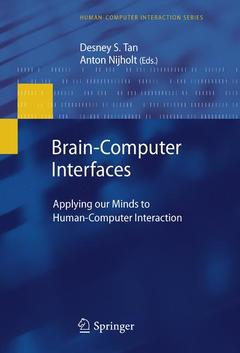Brain-Computer Interfaces, 2010 Applying our Minds to Human-Computer Interaction Human–Computer Interaction Series
Langue : Anglais

For generations, humans have fantasized about the ability to create devices that can see into a person?s mind and thoughts, or to communicate and interact with machines through thought alone. Such ideas have long captured the imagination of humankind in the form of ancient myths and modern science fiction stories. Recent advances in cognitive neuroscience and brain imaging technologies have started to turn these myths into a reality, and are providing us with the ability to interface directly with the human brain. This ability is made possible through the use of sensors that monitor physical processes within the brain which correspond with certain forms of thought. Brain-Computer Interfaces: Applying our Minds to Human-Computer Interaction broadly surveys research in the Brain-Computer Interface domain. More specifically, each chapter articulates some of the challenges and opportunities for using brain sensing in Human-Computer Interaction work, as well as applying Human-Computer Interaction solutions to brain sensing work. For researchers with little or no expertise in neuroscience or brain sensing, the book provides background information to equip them to not only appreciate the state-of-the-art, but also ideally to engage in novel research. For expert Brain-Computer Interface researchers, the book introduces ideas that can help in the quest to interpret intentional brain control and develop the ultimate input device. It challenges researchers to further explore passive brain sensing to evaluate interfaces and feed into adaptive computing systems. Most importantly, the book will connect multiple communities allowing research to leverage their work and expertise and blaze into the future.
Overview and Techniques.- Brain-Computer Interfaces and Human-Computer Interaction.- Neural Control Interfaces.- Could Anyone Use a BCI?.- Using Rest Class and Control Paradigms for Brain Computer Interfacing.- EEG-Based Navigation from a Human Factors Perspective.- Applications.- Applications for Brain-Computer Interfaces.- Direct Neural Control of Anatomically Correct Robotic Hands.- Functional Near-Infrared Sensing (fNIR) and Environmental Control Applications.- Cortically-Coupled Computer Vision.- Brain-Computer Interfacing and Games.- Brain Sensing in Adaptive User Interfaces.- Enhancing Human-Computer Interaction with Input from Active and Passive Brain-Computer Interfaces.- Brain-Based Indices for User System Symbiosis.- From Brain Signals to Adaptive Interfaces: Using fNIRS in HCI.- Tools.- MATLAB-Based Tools for BCI Research.- Using BCI2000 for HCI-Centered BCI Research.
Desney Tan has been a Researcher in the Visualization and Interaction Area at Microsoft Research since 2004, and now manages the Computational User Experiences group. He also holds an affiliate faculty appointment in the Department of Computer Science and Engineering at the University of Washington. Desney’s research interests include Human-Computer Interaction and Physiological Computing. In general, he spends large chunks of time applying signal processing and machine learning to recognizing noisy signals, specifically those in or on the human body, and using them in interesting ways. However, he is a somewhat schizophrenic researcher and has worked on projects in many other domains. Desney received his Bachelor of Science in Computer Engineering from the University of Notre Dame in 1996, after which he spent a couple of years building bridges and blowing things up in the Singapore Armed Forces. He later returned to Carnegie Mellon University, where he worked with Randy Pausch and earned his PhD in Computer Science in 2004. Desney was honored as one of MIT Technology Review's 2007 Young Innovators Under 35 for his work in braincomputer interfaces, as well as named one of SciFi Channel's Young Visionaries at TED 2009. For more complete CV and publications list, see: http://research.microsoft.com/~desney/cv.htm and http://research.microsoft.com/~desney/publications.htm. Anton Nijholt studied mathematics and computer science at Delft University of Technology in the Netherlands. He obtained a PhD from the Vrije Universiteit in Amsterdam in 1980 and since then he has held positions at universities in Canada, Belgium and the Netherlands before settling down as full professor of computer science at the University of Twente in the Netherlands. In 1996 he spent a sabbatical year on studying (computational) humor at the Netherlands Institute for Advanced Study in the Humanities and Social Sciences in Wassenaar, the Netherlands. Currently he is heading the HumanMedia Intera
Explores challenges and opportunities for using brain sensing in HCI, in particular for intentional brain control and for evaluation and adaptation of user interfaces Surveys Human-Computer Interaction solutions to Brain-Computer Interface research, in particular the design of engaging and intelligent user interfaces A broad survey for HCI researchers of research in the Brain-Computer Interface domain Includes supplementary material: sn.pub/extras
Date de parution : 09-2012
Ouvrage de 277 p.
15.5x23.5 cm
Date de parution : 06-2010
Ouvrage de 277 p.
15.5x23.5 cm
© 2024 LAVOISIER S.A.S.



